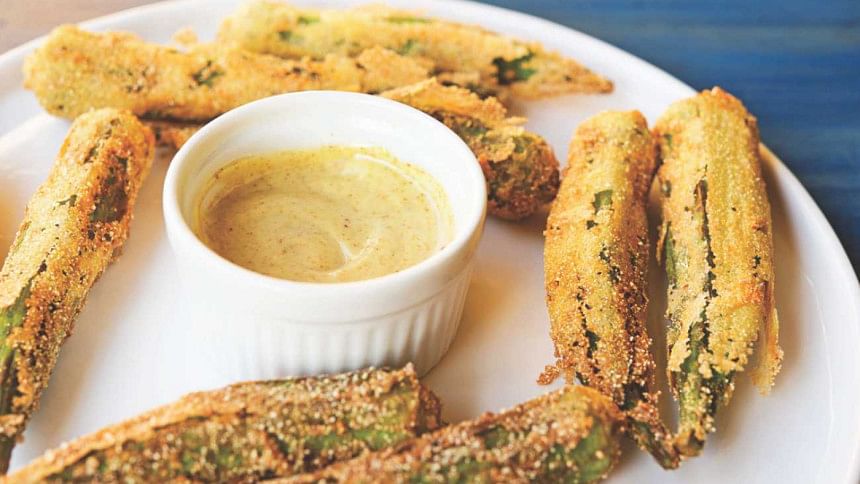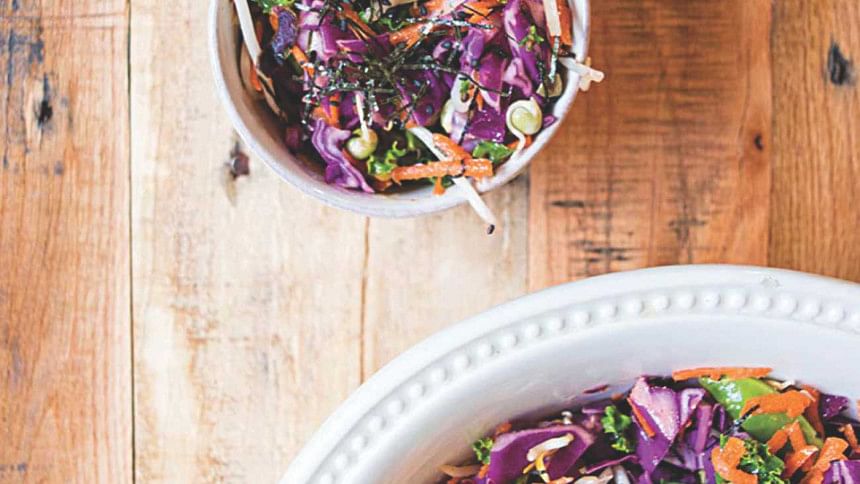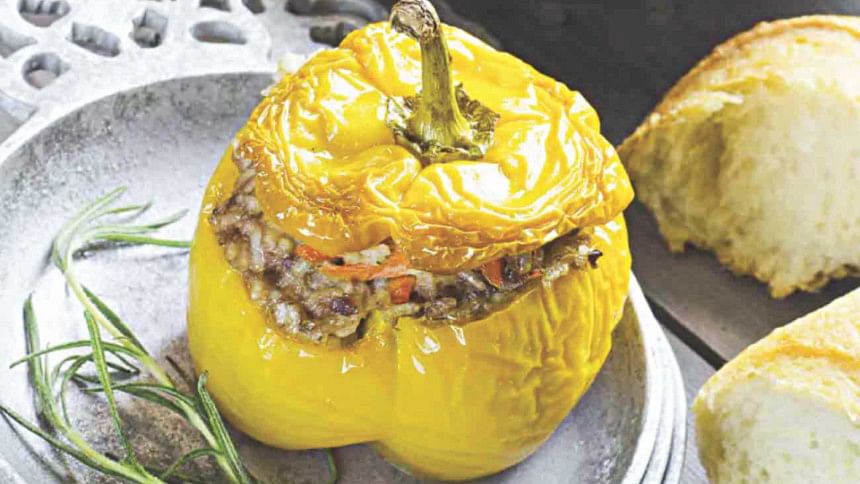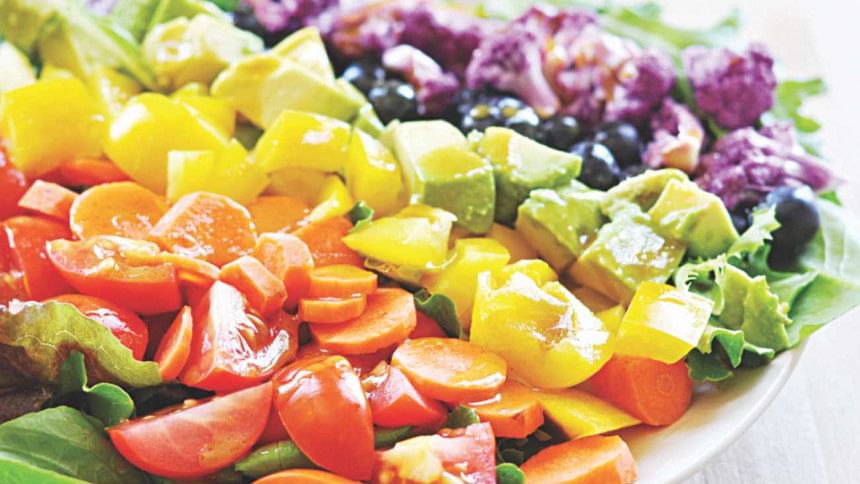Coloured vegetables

Ever heard of a food item that promises health and exhibits an exciting play of flavour and colour on our plates? We speak of vegetables of unparalleled taste, irresistible colour and loaded with nutrients. They fit easily into our culinary adventures and when added to preparations, bring alive even the most mundane affairs.
Vegetables provide health benefits and are important for the prevention of illnesses. They generally contain little fat, cholesterol or sodium and provide complex carbohydrates, fibre and nutrients.
Most are low in calories, and they contain natural sugar, as opposed to refined sugar, which can cause abrupt fluctuations in your blood sugar level.
Different colours indicate different nutrient profiles, so focus on getting a little of each colour in your diet every day to maximise the nutritional benefits.
The U.S. Department of agriculture recommends filling half of your plate with vegetables and fruits at each meal. They contain variety of nutrients including vitamins, minerals and antioxidants.
Red vegetables
Red vegetables, such as tomatoes, red cabbage, beet, red peppers, red onions, and red potatoes are likely to be rich in antioxidants like lycopene and anthocyanin. A medium raw tomato provides 3.2 micrograms of lycopene, a carotenoid that helps your body make vitamin A.
Orange and yellow vegetables
Orange and yellow vegetables such as carrot, pumpkin, yellow peppers, sweet corn, yellow tomato are rich in beta-carotene, which your body converts to vitamin A, nutrients that not only improves night vision, but also helps keep your skin, teeth and bones healthy. They also contain folate, an antioxidant that prevents neural tube defects in unborn infants.
Green vegetables
These are good for your eyes, bones and teeth, and their vitamin K content helps your blood to clot properly.

Blue and purple vegetables
Blue and purple vegetables like black olives, purple cabbage, eggplants, purple cauliflower, and purple potatoes contain anthocyanin, natural plant pigments with powerful antioxidant properties that may reduce your risk of cardiovascular disease. They also contain flavonoids and elegiac acid, compounds that may destroy cancer cells. They also fight cancer cells in the lungs, stomach, breasts and pancreas.
White vegetables
White vegetables, including green bananas, cauliflower, cucumbers are high in dietary fibre, helping to protect you from high cholesterol and they may also lower your risk of stroke.
Chop and toss them in garden fresh salads or make wholesome, sandwiches, to dips, chutneys and even desserts. These are fairly versatile; you may cook it as you please. And just in case you run out of ideas, we have an exciting list of recipes that you can easily pull off.
Beetroot milk shake
The radiant beetroot has been identified as a super food due to its immense nutritional value. Beetroot can benefit our health in multiple ways. It is low in calories and has almost negligible fat content. It helps reduce blood pressure, aids in the production of red blood cells and is a natural blood purifier.
Beetroot is an excellent source of iron and is great for maintaining healthy haemoglobin levels. It has anti-ageing properties and assists in maintaining glowing skin and lustrous hair.
Ingredients
2 beetroots, boiled with skin on, peeled and cut into chunks
2 tbsp sugar syrup
200ml milk, chilled
½ tsp cinnamon powder
2 scoops vanilla ice cream
Method
In a blender make a purée of the beetroot. Add sugar syrup, milk, crushed ice and cinnamon powder. Blend till smooth. Add vanilla ice cream and mix. Serve chilled.
Tip
To ensure that the nutrients and colour of the beetroot remains intact, do not remove its skin before boiling it. Once cooked, rub off the skin under cold running water.

Stuffed capsicum
Capsicum is found in a variety of vibrant colours, which when added to meals, can bring alive even the most mundane preparations. Cultivated and consumed all across the globe, the capsicum comes in different varieties, most of them being yellow, red, orange and green. Capsicum is alternatively and popularly known as bell pepper. It is one of the most widely consumed vegetables across the globe. Rich in vitamin B6, magnesium, lycopene, potassium, folate, and vitamin A and C, this veggie can do wonders for your skin and heart. Including it in your daily diet can help strengthen immunity, lower cholesterol and blood pressure. Regular consumption can also help in revving the metabolic rate.
Ingredients
4 capsicums, de-seeded (red, yellow, green, orange)
2 tsp refined oil
1 tsp cumin
2 onion, chopped
1 tsp ginger, chopped
1 tsp coriander powder
Salt to taste
½ tsp red chilli powder
15 cashew nuts, coarsely bashed
10 raisins
1 tsp butter
1 large potato, boiled and mashed
½ cup cheese, grated and 1 tbsp for garnish
1 tsp mustard sauce
½ lime juice
1 tsp chaat masala
1 tbsp fresh coriander
2 tsp oil, to sear the capsicum
Method
Pre-heat the oven for 10 minutes at 180 degrees C. In a pan add 1 teaspoon butter and lightly sauté cashew nuts and raisins for 2 minutes. Remove from heat and keep aside. In the same pan, add 2 teaspoon oil and cumin seeds. Sauté onions, ginger, garlic and green chilli. Now add the coriander powder, salt, red chilli powder. Add a little water to de-glaze. Now add the sautéed dry fruits, mashed potatoes, grated cheese and mustard sauce. Mix well.
Add lime juice, chaat masala and fresh coriander leaves. Mix well and keep aside. The stuffing is ready. In a pan add 2 teaspoon oil, place the de-seeded capsicums and sear them till brown spots appear on all sides. Stuff the capsicums with the prepared stuffing. Garnish with some grated cheese. Sprinkle some chaat masala if desired and bake in the oven for 10 minutes at 180 degrees C.

Pumpkin soup
Pumpkin is an extremely nutrient dense food, meaning it is chock-full of vitamins and minerals but low in calories. It is one of the best known sources of beta-carotene, a powerful antioxidant. Beta-carotene is converted to vitamin A in the body once it is eaten. There are many creative ways pumpkin can be incorporated into meals, including desserts, soups, salads, preserves, and even as a substitute for butter.
Ingredients
1 kg pumpkin, peeled, cut into small cubes
2 bunches coriander, roots trimmed
1 lemon, zest and juice
2 garlic cloves
1/3 cup olive oil
1 onion, chopped
2 tsp grated ginger
1 tbsp Thai red curry paste
2 cups vegetable stock
400ml light coconut milk
For garnish, thinly sliced red onion and red chilli
Method
To make the coriander paste, process coriander, lemon zest, lemon juice and garlic in a food processor. Slowly add 3 tablespoons of oil to give a saucy consistency, adding a little warm water if necessary and season. Heat the remaining oil in a large pan over medium heat. Add ginger and paste and stir for 1 minute. Add pumpkin and stock, bring to boil, and then simmer over low heat for 15 minutes until pumpkin is cooked. Cool slightly and blend until smooth. Return to the pan; add the coconut milk and season. To serve, place soup in a bowl and swirl in a spoonful of paste. Garnish with the onion, chilli and reserved coriander leaves.
Cinnamon carrot muffins
Carrots are crunchy, crispy and have a sweet, subtle and pleasant taste. Some like to chomp them raw and some like them glazed, baked, grilled or roasted. Carrots come in many different colours — orange, white, yellow, red and purple. Orange carrots are most popular around the world. Carrots are used in vegetables, daal, salads, juice and desserts. It does not just sharpen your eyesight, but can also restore it.
Carrots are a great source of antioxidants, vitamin A and vitamin C. They are also rich in alkali, a chemical which works as a blood purifier. They are high in calcium, keep the intestines free from bacteria and can help lower alarmingly high levels of uric acid.
Ingredients
3 cup carrots, grated
2 cups all-purpose flour
1 cup mixed nuts, chopped
2 tsp baking powder
Pinch of salt
½ tsp cinnamon powder
2 cup brown sugar or jaggery
1½ cup oil
4 eggs, lightly beaten
Pastry cups and muffin pans
Method
Roll nuts in some flour and keep aside. Sift flour, baking powder, salt and cinnamon. Add to this the brown sugar/ jaggery, oil and beaten eggs. Mix well. Mix in the carrots and nuts. Put the batter into the pastry cups (not more than ½ full) and bake in a pre-heated oven for 15-20 minutes. Remove from the oven and leave to cool. Serve.

Rainbow salad
Ingredients
2 small carrots
2 cucumbers
1 cup shredded red cabbage
2 tomatoes
1 red sweet potato
2 green onion, thinly sliced
50g salad leaves
50g fried noodles
2 tbsp rice bran oil
2 tbsp sweet chilli sauce
2 tbsp lemon juice
1 tsp fresh ginger, finely grated
Method
Using a vegetable peeler, cut thin ribbons form carrots, cucumbers, tomatoes and sweet potato. Place in a large bowl. Add red cabbage, onion, salad leaves and noodles. Toss to combine. Whisk rice bran oil, sweet chilli sauce, lemon juice and grated ginger together in a small bowl. Add to carrot mixture. Toss gently to combine and serve immediately.
Fried okra
Okra is also known as ladies-finger. It is widely used in Indian, Middle-Eastern, and Caribbean kitchens. Okra is a magical vegetable whose texture varies dramatically depending on how it is cooked. Whether fried, pickled, or grilled, no other vegetable tastes quite like okra.
It contains potassium, vitamin B, vitamin C, folic acid, and calcium. It is low in calories and has high dietary fibre content. Recently, a new benefit of including okra in your diet is being considered. Okra has been suggested to help manage blood sugar in cases of type 1, type 2, and gestational diabetes.
Ingredients
500g okra
2 eggs
1½ cup corn meal, corn flour or semolina
Salt to taste
¼ tsp freshly ground black pepper
Oil for frying
Method
Trim the stem ends off the okra pods. Cut the pods into bite-size pieces, set aside. In a large bowl, beat the eggs with 2 tablespoons of water. Beat them well so the mixture is of a uniform, watery consistency. Set aside. In a second large bowl, combine the corn meal, salt, and peppers and set aside. Heat oil in a pan. While the oil starts heating, put the okra in the egg and toss it to thoroughly and completely coat the pods, lift the okra out. Now put the egg-coated okra in the corn meal and the other hand to toss it to coat it completely with the corn meal mixture. Repeat with remaining okra pods. Fry the coated okra till golden brown and crispy. Serve fried okra hot.
Photo: Collected

 For all latest news, follow The Daily Star's Google News channel.
For all latest news, follow The Daily Star's Google News channel. 



Comments